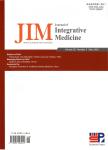Acupuncture for migraine without aura:a systematic review and metaanalysis
Acupuncture for migraine without aura:a systematic review and metaanalysis作者机构:Department of Acupuncture Longhua HospitalShanghai University of Traditional Chinese Medicine Literature and Information Section Shanghai Research Institute of Acupuncture and Meridian
出 版 物:《Journal of Integrative Medicine》 (结合医学学报(英文版))
年 卷 期:2018年第16卷第5期
页 面:312-321页
核心收录:
学科分类:1007[医学-药学(可授医学、理学学位)] 1005[医学-中医学] 1002[医学-临床医学] 100512[医学-针灸推拿学] 10[医学]
基 金:supported by grants from the National Natural Science Foundation of China(No.81603697) key disciplines of the special project from the Chinese State Administration of TCM(No.GJZYJZJ-2010) key projects of the Shanghai Committee of Science and Technology of China(Nos.14401971300,16401970300) the characteristic acupuncture therapy project of the Shanghai Municipal Commission of Health and Family Planning of China(No.ZJ2016001) the TCM genre programme of the Shanghai Health Bureau(No.ZY3-CCCX-1-1007)
主 题:Acupuncture Migraine without aura Meta-analysis Systematic review
摘 要:Background: Migraine without aura (MWoA), the most common type of migraine, has great impacts on quality of life for migraineurs. Acupuncture is used in the treatment and prevention of migraine for its analgesic effects. Objective: The aim of this systematic review and meta-analysis is to systematically assess the therapeutic and preventive effect of acupuncture treatment and its safety for MWoA,Search strategy: Nine electronic databases (PubMed, MEDLINE, Cochrane Library, Lilacs, Embase, China National Knowledge Infrastructure (CNKI), Chongqing VIP (CQV1P), Wanfang Data and Chinese Clinical Trial Registry (ChiCTR)) were systematically searched from their beginning through June 2017 using MeSH terms such as "acupuncture, acupuncture therapy, electro-acupuncture, ear acupuncture, acupuncture points, acupuncture analgesia," and "migraine disorders, cluster headache." Manual searching included other conference abstracts and reference lists. Inclusion criteria: Randomized controlled trials (RCTs) with a clinical diagnosis of MWoA, which were treated with acupuncture versus oral medication or sham acupuncture treatment. Data extraction and analysis: Two evaluators screened and collected literature independently; they extracted information on participants, study design, interventions, follow-up, withdrawal and adverse events and assessed risk of bias and quality of the acupuncture intervention. The primary outcomes were frequency of migraine (FM) and number of migraine days (NM). Secondary outcomes included the visual analogue scale (VAS) score, effective rate (ER) and adverse events. Pooled estimates were calculated as mean difference (MD) with 95% confidence interval (CI) for continuous data and relative risk (RR) with 95% CI for dichotomous data. Results: Overall, 14 RCTs including 1155 participants were identified. The analysis found that acupunc- ture had a significant advantage over medication in reducing FM (MD)=-1.50; 95% CI: -2.32 to -0.68; P〈 0.001) and VAS score (MD =0.97; 95% CI: 0.63-1.31; P〈 0.00001) and had a higher ER (RR = 1.30; 95Z Cl: 1.16-1.45; P 〈 0.00001). Acupuncture also had a significant advantage over sham acupuncture in the decrease of FM (MD = -1.05; 95% CI: -1.75 to -0.34; P=0.004) and VAS score (MD = -1.19; 95g CI: -1.75 to -0.63; P〈 0.0001). Meanwhile, acupuncture was more tolerated than medication because of less side effect reports (RR= 0.29; 95% CI: 0.17-0.51; P〈 0.0001). However, the quality of evidence in the included studies was mainly low (to very low), making confidence in the FM and VAS score results low. Conclusion: Our meta-analysis shows that the effectiveness of acupuncture is still uncertain, but it might be relatively safer than medication therapy in the treatment and prophylaxis of MWoA. Further proof is needed.



